Статьи журнала - Saratov Medical Journal
Все статьи: 92
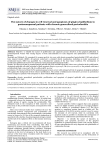
Статья научная
Objective: to identify the nature of proliferation and apoptosis process disorders in the gingival epithelium in postmenopausal women with varying degrees of bone mineralization for early diagnosis and optimization of combination therapy. Materials and Methods. We examined 80 women aged 55–60 years with chronic generalized periodontitis (CGP) and reduced bone mineral density (BMD). All patients underwent a standard dental examination, including an index assessment of periodontal tissues. BMD was quantified via a densitometric analysis of the bone tissue condition. The investigation of periodontal epithelial cell renewal was performed using immunohistochemical studies. Results. We discovered that in postmenopausal patients with CGP and BMD disorders, there was a reduction in the proliferation of gingival epithelial cells with activation of their apoptosis (Iapt=0.73±0.03%, Iki-67=11.77±0.27%) vs. the patients with intact periodontium (Iapt 0.29±0.04%, Iki-67=9.88±0.09%), p=0.04. Conclusion. We discovered that CGP in postmenopausal women occurs with enlarged activity of apoptosis of gingival epithelial cells against the background of their reduced proliferation. The activity of inflammatory destructive processes in periodontal tissues is higher in patients with osteopenia vs. those without BMD impairment.
Бесплатно
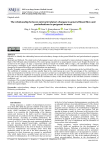
Статья научная
Objective: to identify the relationship between microcirculatory changes in the general blood flow and periodontium in pregnant women. Materials and Methods. The study involved 98 pregnant women who were examined for microcirculatory changes in the fourth finger of the left hand and periodontium. The control group consisted of 30 nonpregnant women. Laser Doppler flowmetry was carried out in two stages. At stage 1, vasomotor activity of vessels was studied, while at stage 2, the contribution of high- and low-frequency oscillations to the overall modulation of blood flow was examined. A correlation analysis of microcirculatory changes in the general blood flow and periodontium was performed. Results. Pregnant women exhibited a reduction in vasomotor activity of vessels and a deterioration in the local blood flow rate. The coefficient of variation was 1.6 times smaller than in the control group (p=0.03). The percentages of the contribution of pulse and respiration waveforms were 7.6 (p=0.03) and 1.5 times (p=0.03) higher than in the control group, in the modulation spectrum of which the amplitude of myogenic genesis prevailed. We revealed a functional relationship between the local blood flow rate in the oral cavity microvessels and the vasomotor activity of the fourth finger of the left hand (Pearson correlation coefficient: 1.0). Conclusion. The revealed relationship confirms the homogeneity of changes in microcirculatory disorder both in periodontium and in the general blood flow in the entire body. This fact must be taken into account when managing pregnant women by a dentist and a gynecologist.
Бесплатно

Статья научная
Background. The formation and development of industrial model for social processes and systems in the early twentieth century brought to life a novel form of organizing scientific activity via establishing research institutions. Objective. This study aimed to investigate the gaps in the history of traumatology institutions in the early years of the Soviet State. Materials and methods. We carried out a comprehensive analysis to retrieve the data from both State and institutional archives, as well as from the literature sources. The narrative analysis was chosen as the method of data interpretation. Most archive documents are made available to the scientific community for the first time. Our study covered the period of time from 1917 to 1930. Over 500 sources were analyzed. Results. We established that the first five traumatology institutions were founded in the following sequence: Saratov Traumatology Institute in 1919, Rostov Traumatology Institute in 1920; Astrakhan, Moscow Oblast, and Voronezh Traumatology Institutes in 1921. The concept of research institution was mainly designed to achieve the systematic augmentation of scientific knowledge and form a new employee type called a professional scientist. Conclusion. Discovering the history of establishing first traumatology institutions that provided healthcare services and conducted independent scientific studies led us to defining a new, previously unexplored institutionalization stage of Russian traumatology and orthopedics. In the early years of the Soviet State, research institutions facilitated the development and implementation of efficient medical technologies into healthcare practice.
Бесплатно
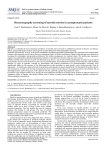
Ultrasonography screening of carotid arteries in asymptomatic patients
Статья научная
Objective: to identify the most important predictors of carotid artery stenosis in ambulatory patients of Saratov and Saratov Oblast, using multivariate analysis, and to specify an ideal patient for ultrasonographic screening. Materials and methods. In 2014-2018, field consultations and ultrasonographic examinations were performed for asymptomatic patients with suspected carotid artery disease at outpatient clinics of Saratov and Saratov Oblast. Such patients were referred for screening by neurologists and general practitioners. The study encompassed 470 medical charts. The multivariate regression analysis was performed to identify independent predictors of carotid artery stenosis of 50 per cent or more. Results. Carotid artery stenosis of ≥30% was detected in 24.5% (i.e., 115 of 470) of study participants; of ≥50% in 10.2% (48 of 470) patients, and of ≥70% stenosis in 2.9% (14/470) of participants. The multivariate analysis revealed that the odds of finding stenosis of ≥50% in patients, selected by neurologists and general practitioners for ultrasonographic screening, were significantly higher in the presence of the following factors: age exceeding 72, male gender, acute cerebrovascular event in anamnesis > 6 months ago, atherosclerosis of leg arteries, and episodes of speech impairment. We developed the point scale for risk assessment. A point scale for risk assessment has been created. In the absence of prognostic factors, the absolute risk of detecting stenosis ≥50% was just 3%, with 1 point it was 16%, and with 4 points it amounted to >50%. Conclusion. Our analysis enabled us to specify the most significant predictors of carotid artery stenosis in patients observed at outpatient clinics of Saratov and Saratov Oblast, and to obtain a patient model helping to optimize optimize selection for ultrasonographic examination.
Бесплатно
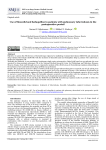
Use of linezolid and bedaquiline in patients with pulmonary tuberculosis in the postoperative period
Статья научная
Objective: to assess the effectiveness of chemotherapy regimens for multidrug-resistant tuberculosis (MDR-TB) and extensively drug-resistant tuberculosis (XDR-TB) with the inclusion of linezolid (Lzd) and bedaquiline (Bq) in patients who underwent a surgery for pulmonary TB. Materials and Methods. A non-randomized continuous single-center retrospective clinical trial based on 154 patients who were operated for drug-resistant pulmonary TB at the National Medical Research Center for Phthisiology and Infectious Diseases, Moscow, Russia, from 2018 through 2023. A comparative analysis of the effectiveness of chemotherapy regimens (depending on the inclusion of new anti-tuberculosis drugs [ATDs]) was performed. Results. The proportions of adverse effects of ATDs in both study groups without taking into account the use of Lzd and Bq were similar: in 24.1% (n=21/87) of cases in Group 1 and in 25.4% (n=17/67) of patients in Group 2. The inclusion of Lzd and Bq in the postoperative chemotherapy regimen (Group 1) significantly reduced the duration of the treatment course to 38.5±2.1 weeks vs. 44.6±2.2 weeks in Group 2. Thus, the favorable outcome occurred 6.1 weeks earlier with the inclusion of Lzd and Bq (p=0.041). Adverse effects of ATDs were observed in 24.1% of patients treated with Lzd and Bq. Conclusion. The inclusion of Lzd and Bq in the MDR-TB and XDR-TB chemotherapy regimens makes it possible to reduce the total duration of the treatment course until a favorable outcome is observed.
Бесплатно
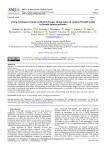
Статья научная
Objective: to assess the informativity of using the cytological rapid method for examining sentinel lymph nodes in patients breast cancer. Materials and Methods. Our included 46 patients 30-85 years of age with verified breast cancer. On the day before the surgery, approximately 150-200 MBq of the 99mTc-NanoTop radiopharmaceutical were injected peritumorally into the parenchyma of the affected mammary gland. After 1.5-2 hours, lymphoscintigraphy was performed, followed by SPECT/CT. The latter helped visualizing sentinel lymph nodes. The next day after the administration of the radiopharmaceutical, during surgery, sentinel lymph nodes were identified using a gamma detector. Further on, the surgeon removed the lymph node(s) and sent it/them for the examination by the cytological rapid method. To assess the informativity of this method, we compared its results the gold standard of morphological diagnostics: histological examination of postoperative material. Results. The cytological rapid method revealed the presence of metastases in sentinel lymph nodes in 12 patients, which substantially influenced their further treatment tactics. We therefore conformed that this method is not inferior to the histological examination of the tumor. The sensitivity and specificity of the cytological rapid method are 100%. When comparing the results of cytological rapid method and planned histological examination, we revealed no discrepancies in diagnoses based on the state of the lymph nodes. Conclusion. Cytological rapid method is an informative method for sentinel lymph node detection in breast cancer patients.
Бесплатно
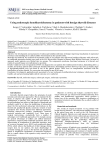
Using endoscopic hemithyroidectomy in patients with benign thyroid diseases
Статья научная
Objective: the development and assessment of endoscopic hemithyroidectomy technique improving visualization of anatomical structures and excluding the so-called conflict of instruments in the operative field. Materials and methods. We analyzed the treatment results of 103 patients who underwent hemithyroidectomy with endoscopic or traditional approaches during 2014-2018 at the S.R. Mirotvortsev Hospital of Saratov State Medical University. In terms of approach mode, patients were divided into two groups. The compression syndrome, functional autonomy of a thyroid, and results of a punch biopsy were indications to operation. Results. Unilateral vocal cord paralysis (UVCP) was diagnosed in one patient after traditional intervention, diminishing after 1.5 months; and in three patients after endoscopic hemithyroidectomy, diminishing anywhere between 7 days and 1.5 months. Signs of hypoparathyroidism were not found in any of the patient groups. There were no complications associated with the introduction of carbon dioxide. No conversion was required in any of the cases. Conclusion. Development, application and assessment of a new endoscopic hemithyroidectomy technique, which proved itself feasible, safe and provisioning highly esthetic outcome were conducted.
Бесплатно
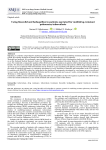
Using linezolid and bedaquiline in patients operated for multidrug-resistant pulmonary tuberculosis
Статья научная
Objective: to evaluate comprehensive treatment outcomes in patients operated for multidrug-resistant pulmonary tuberculosis (MDR-TB) with the inclusion of linezolid and bedaquiline in the chemotherapy (CTX) regimens. Materials and methods. We performed a non-randomized continuous single-center retrospective study on 114 patients operated on at the National Medical Research Center for Phthisiology of the Russian Federation Ministry of Healthcare from 2018 to 2022. We conducted a comparative analysis of the effectiveness of CTX regimens in patients with localized and extensive forms. Results. We detected a statistically significantly wider spectrum of Mycobacterium tuberculosis (MTB) drug resistance (DR) in 41.6% (n=32/77) of patients with tuberculomas and in 18.9% (n=7/37) of patients with fibrous cavernous tuberculosis based on the study of resection specimens vs. respiratory specimens (p=0.03). Inclusion of linezolid and bedaquiline in the CTX regimen for patients with MDR-TB resulted in a reduction in the duration of postoperative treatment by, on average, 14.0±1.3 weeks and 11.1±4.5 weeks, respectively, for localized TB forms and by 14.8±3.2 weeks and 14.9±3.7 weeks, correspondingly, for extensive TB forms vs. CTX regimens without these drugs. Conclusion. Addition of new antitubercular drugs (linezolid and bedaquiline) to the CTX regimen in patients with MDR-TB can reduce the treatment duration in case of both localized and extensive forms of the disease.
Бесплатно

Using neural network for restoring the lost surface of skull bones
Статья научная
Objective: To assess the sensitivity, specificity and accuracy of a digital algorithm based on convolutional neural networks used for restoring the lost surface of the skull bones. Materials and methods. The neural network was trained over 6,000 epochs on 78,000 variants of skull models with artificially generated skull injuries. The key parameters of the algorithm were assessed on 222 series of multislice computed tomography (MSCT) of patients with defects of the skull bones, presented in DICOM format. Results. For the group as a whole, the sensitivity, specificity, and accuracy rates were 95.3%, 85.5%, and 79.4%, respectively. Multiple experiments were conducted with a step-by-step elimination of 3D models in order to find the underlying cause of unsatisfactory outcomes of the skull lost surface restoration. Incorrect identification of the defect zone most often occurred in the area of the facial skeleton. After excluding series with the presence of artifacts, the mean increase in metrics was 2.6%. Conclusion. The accuracy of identifying the reference points (specificity) on a 3D model of the skull by the algorithm had the greatest impact on the ultimate accuracy of repairing the lost surface. The maximum accuracy of the algorithm allowing the use of the resulting surfaces without additional processing in a 3D modeling environment was achieved in series without the presence of artifacts in computed tomography (83.5%), as well as with defects that did not extend to the base of the skull (79.5%).
Бесплатно
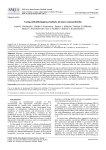
Using orthobiologics products in knee osteoarthritis
Статья научная
Objective: comparison of the treatment effectiveness in patients with grades II or III knee osteoarthritis using autologous bone marrow aspirate concentrate (BMAC) and autologous platelet-rich plasma (PRP) infused intraosseously into the area of overload bone marrow edema. Materials and Methods. The prospective study was conducted on the basis of two medical clinics from 2016 to 2019. It involved 40 patients with grades II–III knee osteoarthritis. The patients of the treatment group underwent a single intraosseous infusion of BMAC, whereas patients in the comparison group were subjected to a single intraosseous PRP infusion. The results were assessed after 1, 3, 6, and 12 months using visual analog scale (VAS), Lequesne index for knee osteoarthritis, WOMAC osteoarthritis index, and verbal rating scale (VRS). Results. After 12 months, there was a reduction in the VAS index to 3.9±0.3 points in the treatment group and 4.2±0.1 points in the control group. Similar decrease was observed for Lequesne index for knee osteoarthritis (to 5.8±0.7 points in the treatment group and to 6.1±0.8 points in the control group) and WOMAC osteoarthritis index (to 40.6±0.3 points in the treatment group and to 42.5±0.6 points in the control group). The VRS scores after 3 and 6 months were better in the treatment group (subjected to autologous BMAC), while after 12 months, the differences between the groups were not significant. Conclusion. Use of orthobiologics products for osteoarthritis treatment was effective, with higher efficacy of intraosseous BMAC infusion vs. PRP infusion in terms of pain, knee functionality, physical activity, and patient satisfaction over the entire monitoring period. Both treatment methods were safe.
Бесплатно
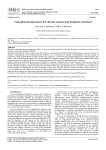
Using pharmacopuncture for chronic tension-type headache treatment
Статья научная
Objective: assessing pharmacopuncture effect on pain syndrome and level of anxiety-depressive disorders in patients with chronic tension-type headache (CTTH). Materials and methods. An open-label controlled trial was conducted on 95 CTTH patients split among two groups by means of adaptive randomization. The comparison group subjects were receiving 35-70 mg/day of amitriptyline and 450 mg/day of tolperisone, while patients of the treatment group were assigned 2-4 courses of pharmacopuncture by the original method. The results were evaluated on the basis of the scores obtained via Visual Analogue Scale (VAS), McGill Pain Questionnaire, Beck Depression Inventory (BDI), and State-Trait Anxiety Inventory (STAI) sensu Ch. Spielberger and Yu. Khanin. Results. Patients in both clinical groups were inclined to a positive evaluation of received treatment. Based on the results of McGill Pain Questionnaire, we determined both affective and sensory pain descriptors, with a predominance of the latter. Both groups exhibited moderate depressive symptoms according to BDI of the psychological status. Prevalence of trait anxiety over reactive anxiety was determined by STAI. According to VAS, pain intensity after the treatment declined from 5.26±0.87 to 1.7±0.78 points (p<0.05) and from 5.17±0.78 to 1.65±0.79 (p<0.05) in the comparison group versus the treatment group. An improvement of anxiety and depression indicators was detected. Conclusion. Our results have demonstrated that pharmacopuncture is very promising in treating CTTH patients.
Бесплатно
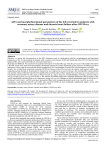
Статья научная
Objective: to assess the concentration of the sST2 biomarker and its relationship with the morphological and functional parameters of the LV myocardium in patients with coronary artery disease (CAD) and functional class (FC) I-III chronic heart failure (CHF), who survived COVID-19 or did not experience it. Materials and Methods. We examined 100 patients (66 males) of median (Me) age of 65 [63; 67] years with stable CAD and FC I-III CHF (sensu New York Heart Association), distributed among two groups depending on the presence of COVID-19 in their anamneses. Along with the conventional clinical examination, the concentration of serum sST2 was determined via ELISA. Results. We revealed that in patients surviving COVID-19 (Group 1), the sST2 level was 38.4 [35.5; 44.8] ng/mL, while in the comparison group (Group 2), it amounted to 29.63 [27.9; 32.7] ng/mL (p<0.001). In Group 1, the end-diastolic volume and the end-systolic volume of the left ventricle (LV) significantly exceeded values of these parameters in Group 2 (p=0.004 and p=0.02, respectively) and amounted to 118.2 [107.5; 166.5] mL and 44.1 [35.0; 58.1] mL, correspondingly, in Group 1 and 107.5 [92.4; 129.5] mL and 37.9 [29.5; 47.4] mL in Group 2. The number of patients with grade 2 diastolic dysfunction (DD) in Group 1 (18–33.9%) significantly exceeded that in the comparison group (7%–14.9%). Changes in global longitudinal strain (GLS) of the LV in Group 1 (-15.6 [-20.8; -13.8] %) were more pronounced than in the comparison group (-19.9 [-21.5; -16.3] %), p=0.018. Conclusion. CAD patients with FC I-III CHF, who survived COVID-19, had statistically significantly higher serum sST2 concentration, more pronounced LV DD, and greater LV GLS.
Бесплатно

